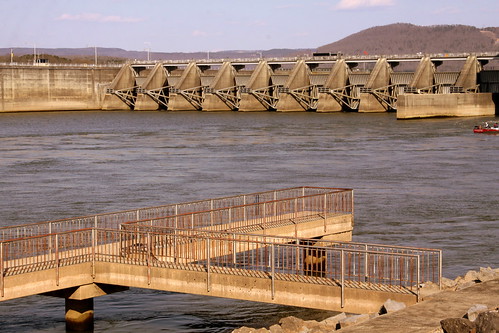
Nickajack Dam is a TVA hydroelectric dam on the Tennessee River just upstream from Chattanooga.
Before the completion of Hales Bar Dam in 1913, the Tennessee River Gorge was one of the major impediments— along with Muscle Shoals and the Elk River shoals— to year-round navigation on the Tennessee River. Along with unpredictable water levels, the gorge was filled with numerous water hazards, some of which had been given nicknames such as "The Suck", "The Skillet", and "The Pan." In the early 1900s, the U.S. Army Corps of Engineers realized that a dam near the southwestern end of the gorge would flood the water hazards and eliminate the gorge's rapid downstream current. Chattanooga engineer Josephus Conn Guild offered to raise funds to build this dam in exchange for rights to the dam's electrical output. After receiving authorization from Congress in 1904, he organized the Chattanooga and Tennessee River Power Company (later TEPCO) in 1905, and the company began building Hales Bar Dam in October of that year. Hales Bar's weak limestone foundation — which hadn't been considered in the selection of the dam site— presented numerous obstacles from the outset, but the dam was finally completed in 1913.
In 1939, after a contentious court battle, TEPCO was forced to sell its assets— including Hales Bar Dam— to the Tennessee Valley Authority. The dam had been leaking since its construction, and TVA immediately initiated a series of foundation improvements that by 1943 had succeeded in halting the leaks. In 1960, however, the leaks had returned, spilling at an alarming 2,000 cubic feet per second. Around the same time, TVA began expanding locks on its dams to at least 600 feet to accommodate the increase in traffic the river had experienced since World War II, and it was determined that expanding the Hales Bar lock would be "prohibitively" expensive. Rather than spend the necessary expenses to upgrade Hales Bar, a decision was made in 1963 to build a new dam altogether on a more solid bedrock a few miles downstream.
The Nickajack Dam project was authorized January 9, 1964, and construction began April 1, 1964. Funding set aside for repair work on Hales Bar was transferred to the Nickajack project. The reservoir's construction— which basically involved extending the Hales Bar Reservoir 6 miles downstream to Nickajack— required the purchase of 8,300 acres, 500 acres of which had to be cleared. 82 families and 8 miles of roads had to be relocated. Two generators and several switchyard parts were moved from Hales Bar Dam to the new dam. Construction was completed on December 14, 1967, at a cost of $73 million. Operations at Hales Bar Dam were halted the following day, and by September 1968, Hales Bar Dam had been dismantled and its reservoir merged with Nickajack Lake.
Great post, with lots of good information, as usual! But, Nickajack is downstream from Chattanooga. Chickamauga is upstream.
ReplyDeleteYou are correct. It must have been too late at night when I wrote it.
Delete